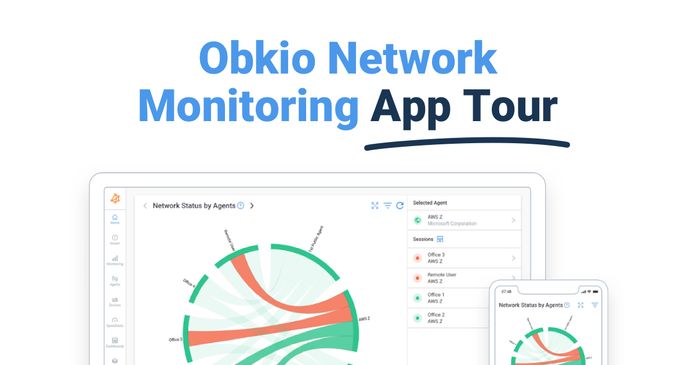Table of Contents
Table of Contents
As organizations increasingly depend on flawless network performance in today's linked world, it is critical to make sure networks are operating smoothly. Network monitoring tools act as digital guardians, keeping a watchful eye on the intricate web of connections and ensuring optimal performance. Among these tools, synthetic network monitoring tools stand out as powerful allies, capable of proactively simulating and detecting network issues before they escalate into a full-blown crisis.
Welcome to our comprehensive guide on the top 30 synthetic network monitoring tools that have revolutionized the way organizations monitor and manage their networks. From ensuring uninterrupted connectivity to identifying bottlenecks and vulnerabilities, these tools serve as invaluable assets for IT professionals, system administrators, and network engineers.
Through this blog, we aim to provide you with an in-depth analysis of the leading synthetic network monitoring tools available today. Whether you are a seasoned network professional seeking to enhance your existing monitoring infrastructure or a novice venturing into the realm of network management, this guide will equip you with the knowledge and insights you need.
First, let's make sure we're all on the same page.
Synthetic network monitoring is a proactive approach to assessing and optimizing network performance by simulating user interactions and generating artificial network traffic (synthetic traffic).
Synthetic network monitoring tools generate synthetic trafficto mimic real user behavior, such as accessing web applications, browsing websites, or transferring data. These synthetic transactions are executed at regular intervals from various geographic locations to measure network latency, packet loss, throughput, and other performance metrics. The goal of synthetic network monitoring is to identify potential performance issues before they impact end-users, allowing organizations to proactively address issues and ensure a seamless user experience.
Learn how to use synthetic monitoring to monitor network performance & identify network issues, and the benefits of synthetic traffic over packet capture.
Learn more

Network monitoring tools play a pivotal role in maintaining network performance, identifying potential issues, and preventing downtime. However, traditional monitoring solutions often rely on reactive approaches, relying on real-time data or alerts triggered by user-reported incidents. While these methods have their place, they may not always capture underlying problems that manifest intermittently or only under specific conditions.
This is where synthetic network monitoring tools step in. By simulating user interactions and network traffic, these tools proactively test the network's responsiveness, reliability, and overall performance. By generating artificial transactions or data packets, synthetic monitoring provides a comprehensive overview of the network's health and its ability to handle various workloads.
With synthetic network monitoring tools, businesses can:
- Identify potential performance bottlenecks and optimize network resources.
- Test and validate network changes and configurations before deployment.
- Monitor the end-user experience across various locations and devices.
- Assess the impact of network changes or updates on critical applications.
- Ensure compliance with service level agreements (SLAs) and minimize downtime.
- Detecting and troubleshooting network issues before they affect end-users.
- Improve incident response times by proactively detecting and isolating issues.
In the upcoming sections, we will explore the top 19 synthetic network monitoring tools, each offering a unique set of features, capabilities, and integrations. By gaining insights into their functionalities, strengths, and potential use cases, you will be better equipped to select the most suitable tool for your specific network monitoring needs.
So, join us on this exciting journey as we delve into the realm of synthetic network monitoring tools and discover the digital guardians that ensure your networks remain robust, reliable, and always ready to meet the demands of today's digital landscape.

Synthetic network monitoring tools have become indispensable in the arsenal of IT professionals and network administrators, empowering them to proactively monitor and optimize network performance. These tools offer a range of functions that help businesses ensure seamless connectivity, enhance user experience, and minimize downtime.
Let's explore some of the top functions of synthetic network monitoring tools:
Performance Testing: Synthetic monitoring tools simulate user interactions and network traffic to assess the performance of critical applications and services. By generating artificial transactions, these tools can measure response times, latency, and throughput across various locations and devices. Performance testing helps identify bottlenecks, optimize network resources, and ensure optimal user experience.
Availability Monitoring: Synthetic network monitoring tools constantly monitor the network availability of network services, servers, and applications. They simulate periodic checks or pings to verify if the resources are accessible and responsive. In case of any unavailability or downtime, these tools trigger alerts, enabling IT teams to swiftly respond and minimize service disruptions.
Load Testing: Load testing is crucial to determine the network's ability to handle increased traffic and workloads. Synthetic monitoring tools simulate heavy user loads and monitor the network's performance under stress. By measuring response times and throughput during peak usage, these tools help organizations identify capacity limits, optimize resources, and plan for scalability.
Synthetic Transactions: Synthetic network monitoring tools perform automated, scripted transactions that mimic user behavior on applications and websites. These synthetic transactions validate end-to-end functionality, ensuring that critical processes such as login, form submission, or data retrieval are working as expected. By continuously executing these transactions, these tools identify potential issues or errors that might impact the user experience.
 Screenshot from Obkio's Synthetic Network Monitoring Tool
Screenshot from Obkio's Synthetic Network Monitoring Tool
5.Notification and Problem Diagnosis: To inform IT teams of any changes from standard network behaviour, synthetic monitoring systems use advanced alerting mechanisms. They generate real-time alert that facilitate prompt incident response and troubleshooting when predetermined thresholds or performance indicators are exceeded. Businesses can lessen the effect on end customers and maintain service levels by quickly identifying and fixing problems.
Geographical Performance Monitoring: With the global nature of businesses, synthetic network monitoring tools offer geographical performance monitoring capabilities. These tools simulate transactions from multiple locations around the world, allowing organizations to assess network performance across different geographical regions. By analyzing response times and latency from various locations, businesses can identify regional disparities and optimize network infrastructure accordingly.
Capacity Planning and Trend Analysis: Synthetic network monitoring tools provide valuable insights into network usage patterns, trends, and capacity requirements. By collecting and analyzing performance data over time, these tools help organizations make informed decisions about network upgrades, capacity planning, and resource allocation. Predictive analytics and trend analysis enable businesses to anticipate future demands and ensure optimal network performance.
SLA Compliance Monitoring: Synthetic monitoring tools assist in monitoring and ensuring compliance with service level agreements (SLAs). By continuously measuring and reporting key performance indicators (KPIs) defined in service or Internet SLAs, these tools help businesses track and demonstrate adherence to contractual obligations. SLA compliance monitoring is essential for maintaining customer satisfaction, identifying areas of improvement, and strengthening relationships with service providers.
Network Troubleshooting: Synthetic monitoring tools aid in network troubleshooting by providing detailed insights into performance issues and anomalies. Through real-time monitoring and synthetic transactions, these tools pinpoint the root cause of problems, enabling IT teams to diagnose and resolve network issues promptly. Network troubleshooting features streamline the incident response process, reducing network downtime and minimizing business disruptions.
Synthetic network monitoring tools has become essential for enterprises looking to keep their networks stable and dependable. These solutions enable network managers and IT specialists to proactively monitor network performance, maximize resources, and guarantee a first-rate user experience by providing an extensive range of functions. Synthetic network monitoring solutions are essential for anything from load testing and alerting to performance testing and availability monitoring.


The landscape of IT software is constantly evolving, and the realm of synthetic network monitoring tools is no exception. With the increasing demand for network performance optimization, numerous software vendors claim to offer synthetic network monitoring functions. As a result, comparing these solutions and understanding the depth of their offerings has become a challenging task for IT professionals and network administrators.
To address this challenge and bring clarity to the landscape, we have taken a systematic approach. We have categorized synthetic network monitoring tools into five distinct families, each with its own unique characteristics and focus. This categorization enables us to group similar tools together, facilitating easier comparison based on their offerings, functionalities, and pricing models.
Let's explore these five families of synthetic network monitoring tools:
Pure Synthetic Network Performance Monitoring:This family comprises software solutions that focus solely on synthetic network performance monitoring. They excel in simulating user interactions, generating artificial transactions, and providing comprehensive insights into network performance metrics. These tools are designed specifically to optimize network resources, identify bottlenecks, and ensure an exceptional user experience.
Traditional Synthetic Network Monitoring: Traditional synthetic network monitoring tools encompass a broader scope of monitoring capabilities. In addition to network performance monitoring, they may include features such as availability monitoring, alerting, and incident response. These tools offer a comprehensive suite of functionalities to monitor and manage network infrastructure, ensuring the smooth operation of critical applications and services.
Application Performance Monitoring Tools with Synthetic Network Monitoring Functions: These solutions provide an integrated perspective of the user experience by fusing the strength of synthetic network monitoring with the capabilities of application performance monitoring (APM). These technologies make it easier to quickly identify and fix problems related to network and application layer performance.
- Web Performance Monitoring Solutions with Synthetic Network Monitoring: Solutions for web performance monitoring that have synthetic network monitoring built in to allow companies to assess, examine, and enhance the functionality of their online applications in a range of network conditions.
By dividing synthetic network monitoring tools into these categories, we aim to simplify the process of comparing and selecting the most suitable solution for your organization's specific needs. Each family represents a distinct set of functionalities, offering a focused approach to network monitoring.
This categorization helps in understanding the depth of the tools' offerings and facilitates more accurate comparisons in terms of features, performance, and pricing.
In the upcoming sections, we will delve into each family, exploring the top tools within them, highlighting their unique capabilities, and providing insights into their strengths and potential use cases.
By grouping these solutions based on their offerings and functionalities, we aim to provide a comprehensive and structured overview, empowering you to make informed decisions and select the synthetic network monitoring tool that best aligns with your requirements.
Stay tuned as we embark on a journey through the diverse world of synthetic network monitoring tools, helping you navigate the complexities and find the perfect fit for your network monitoring needs.
In this section, we will explore six synthetic network performance monitoring tools that excel in simulating user interactions and providing comprehensive insights into network performance metrics. These tools focus on optimizing network resources, identifying bottlenecks, and ensuring exceptional user experiences.
Obkio's Synthetic Network Monitoring Tool is a simple Network Monitoring and Troubleshooting SaaS solution designed to monitor end-to-end network performance ( WAN to LAN) from the end user perspective for all network types (SD-WAN, MPLS, LAN, WAN L@ et L3 VPN). With a primary focus on synthetic monitoring, Obkio revolutionizes the way organizations assess and enhance their network infrastructure.
Obkio leverages Network Monitoring Agents and synthetic traffic to continuously identify the causes of intermittent VoIP, video, and applications slowdown in seconds - and identify the data you need to troubleshoot and ultimately improve the end-user experience.
Synthetic Traffic Generation: Obkio empowers organizations to simulate user behavior and generate synthetic traffic within their network environment. This proactive approach enables the identification of potential performance issues before they impact end-users.
End-User Experience Monitoring: By emulating user interactions, Obkio provides invaluable insights into the end-user experience. Organizations can accurately assess application responsiveness, page load times, and overall user satisfaction.
Continuous Measurement of Network Metrics: Obkio ensures continuous measurement of network metrics, allowing organizations to monitor key performance indicators in real-time. From bandwidth utilization to latency and packet loss, Obkio provides a comprehensive view of network health.
Proactive Issue Identification: With synthetic monitoring, organizations can proactively identify and address potential performance issues before they impact end-users. This proactive approach minimizes downtime and ensures a seamless digital experience.
User-Friendly Interface: Obkio offers a user-friendly interface with intuitive dashboards and customizable reports. IT professionals can easily navigate through network performance data and gain actionable insights to optimize network efficiency.
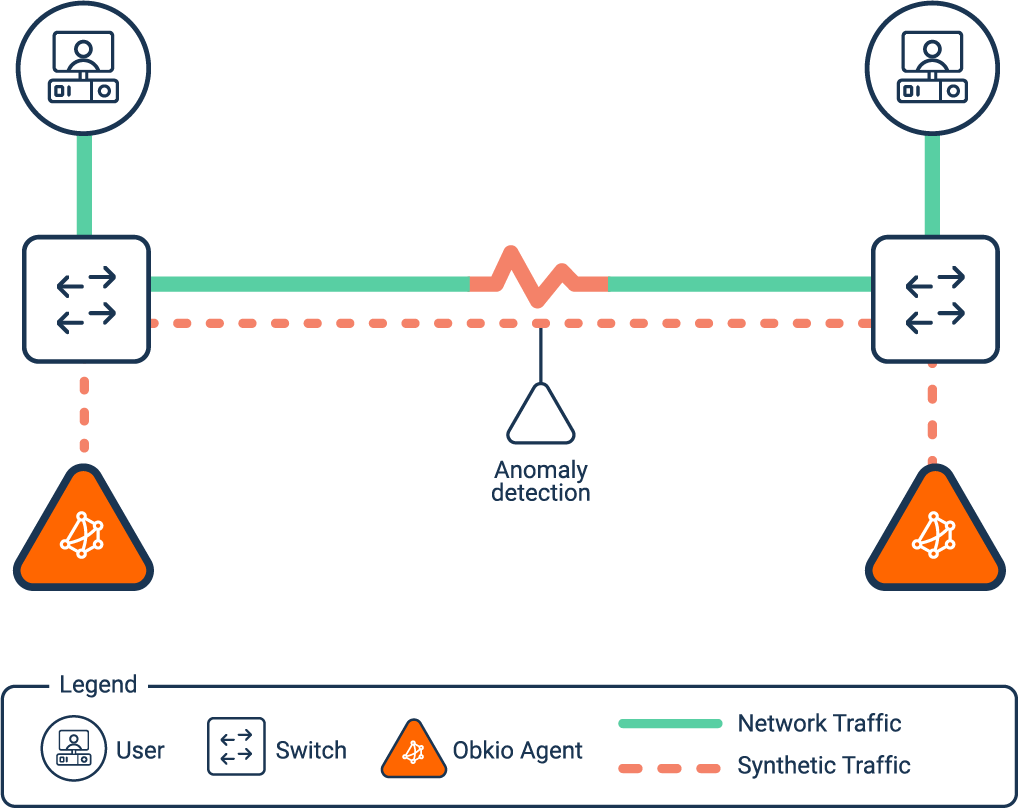
Obkio’s Pricing:
Customers of Obkio have good news: the company's network performance monitoring solution has an easy-to-understand pricing structure that doesn't require an hour-long explanation from their sales staff. Obkio's price is based on a fixed monthly rate per monitoring agent, device, and user; there are no additional fees associated with data usage, bandwidth, or other difficult-to-estimate parameters. We don't have any hidden costs or fees.
- Free : 2 Agents | 1 Device | 1 User (Limited Functionality)
- $399 / month : 10 Agents | 5 Devices | 2 Users
- $699 / month : 10 Agents | 10 Devices | 5 Users
- Additional Fees for Additional Agent, Device and User

You can create a custom plan and receive a personalized estimate using Obkio's Price Calculator, which you may use for the planning and budgeting requirements of your company.
Learn more here : https://obkio.com/pricing/
Free Trial: https://obkio.com/signup/
Obkio’s User Interface:
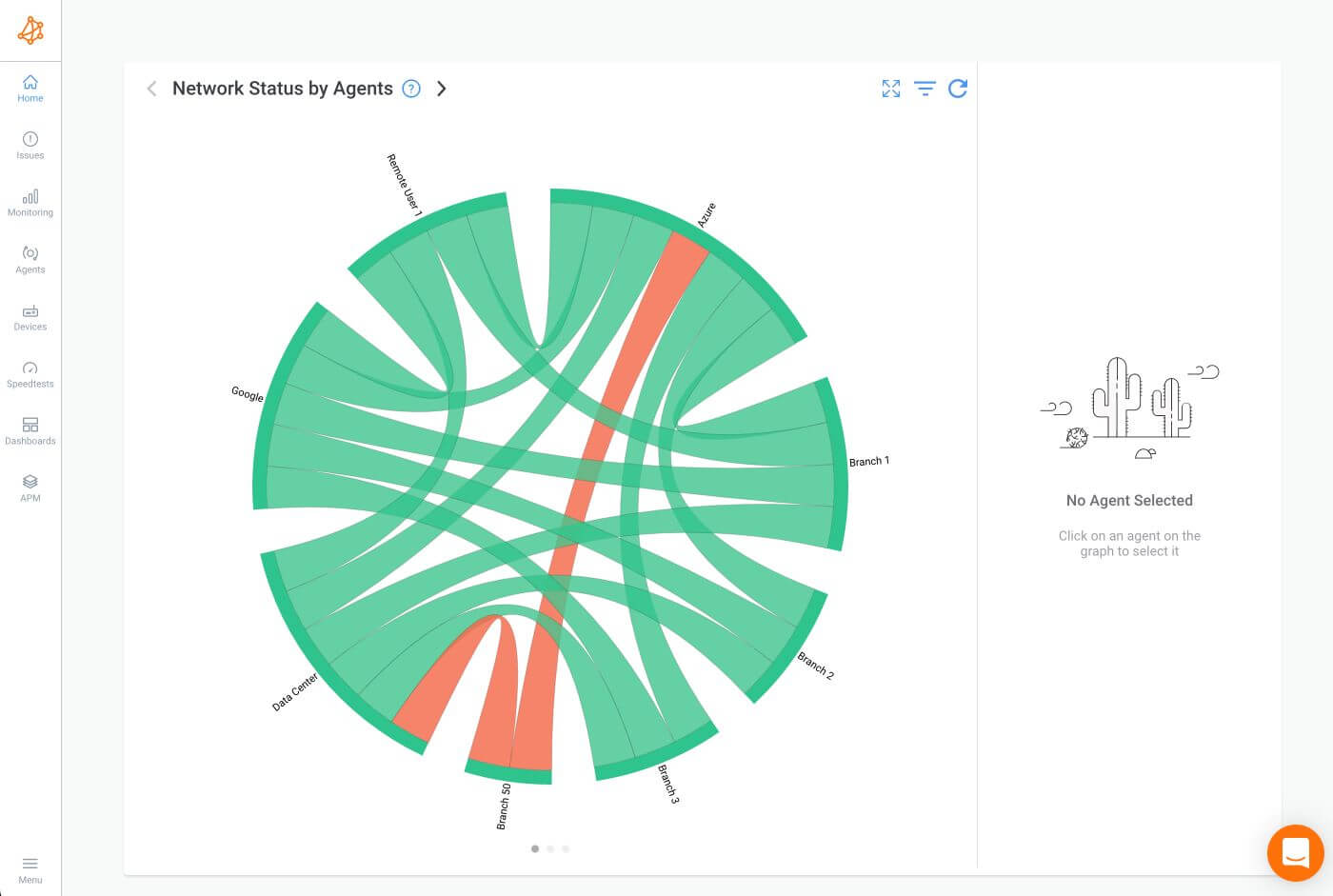
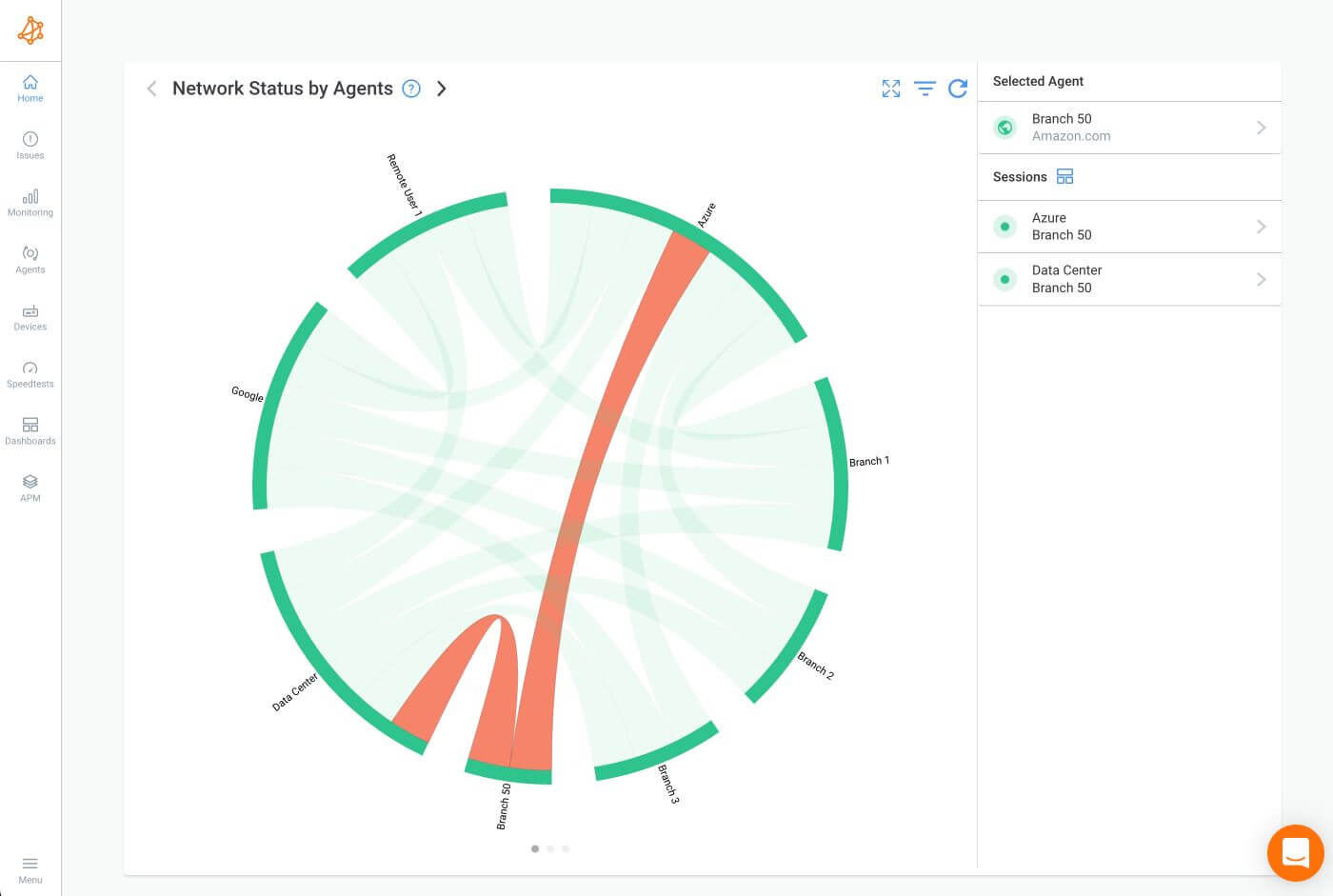
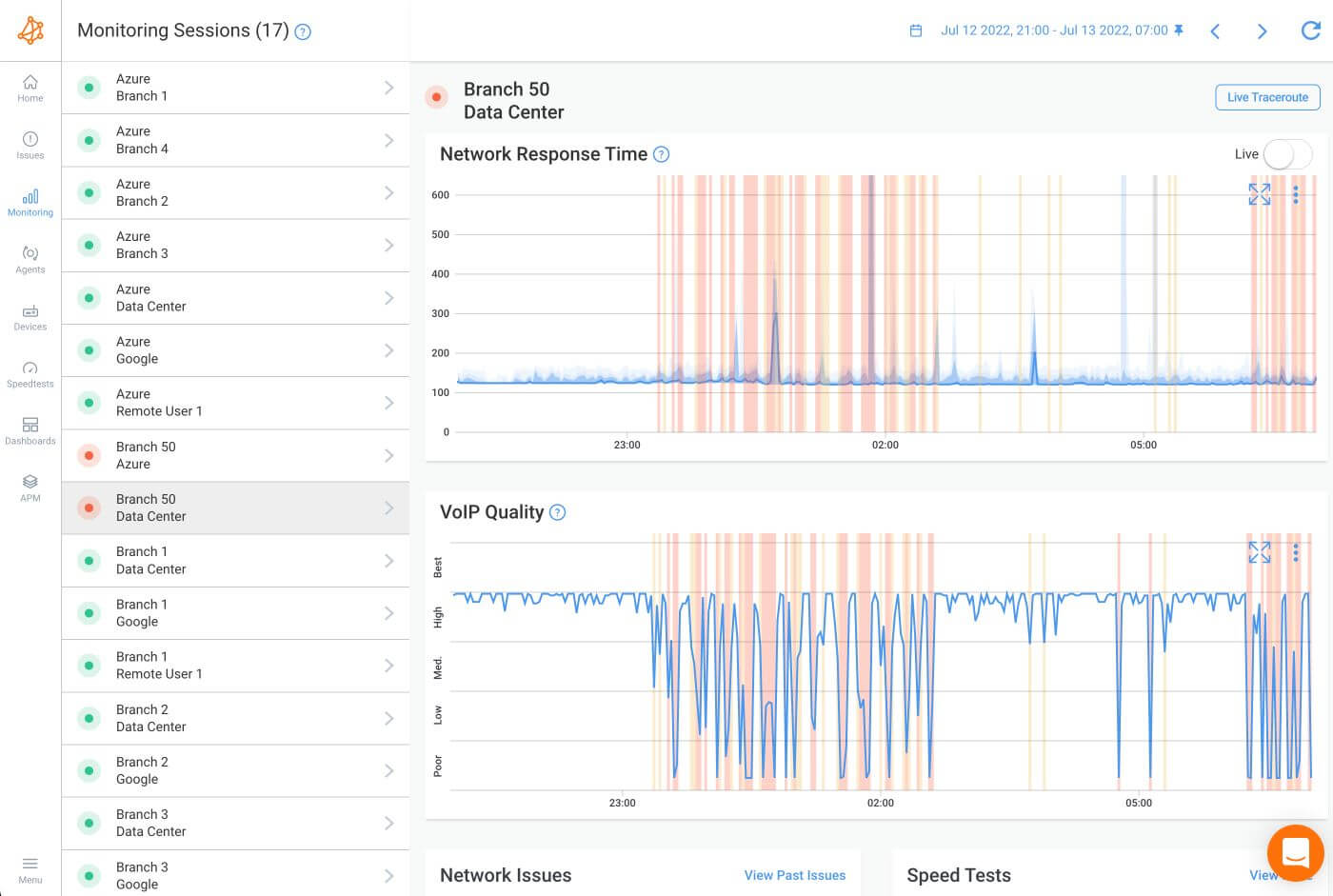

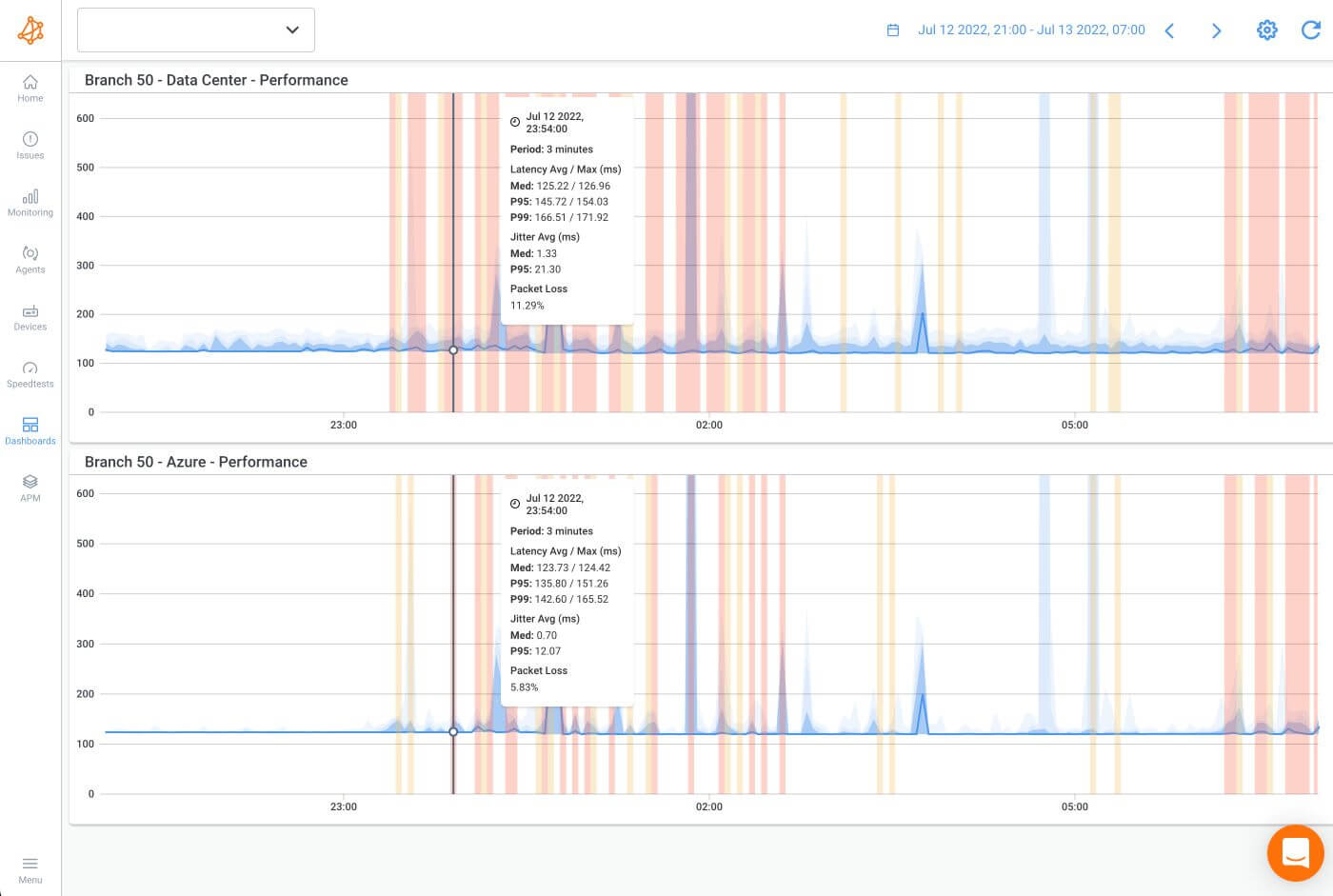
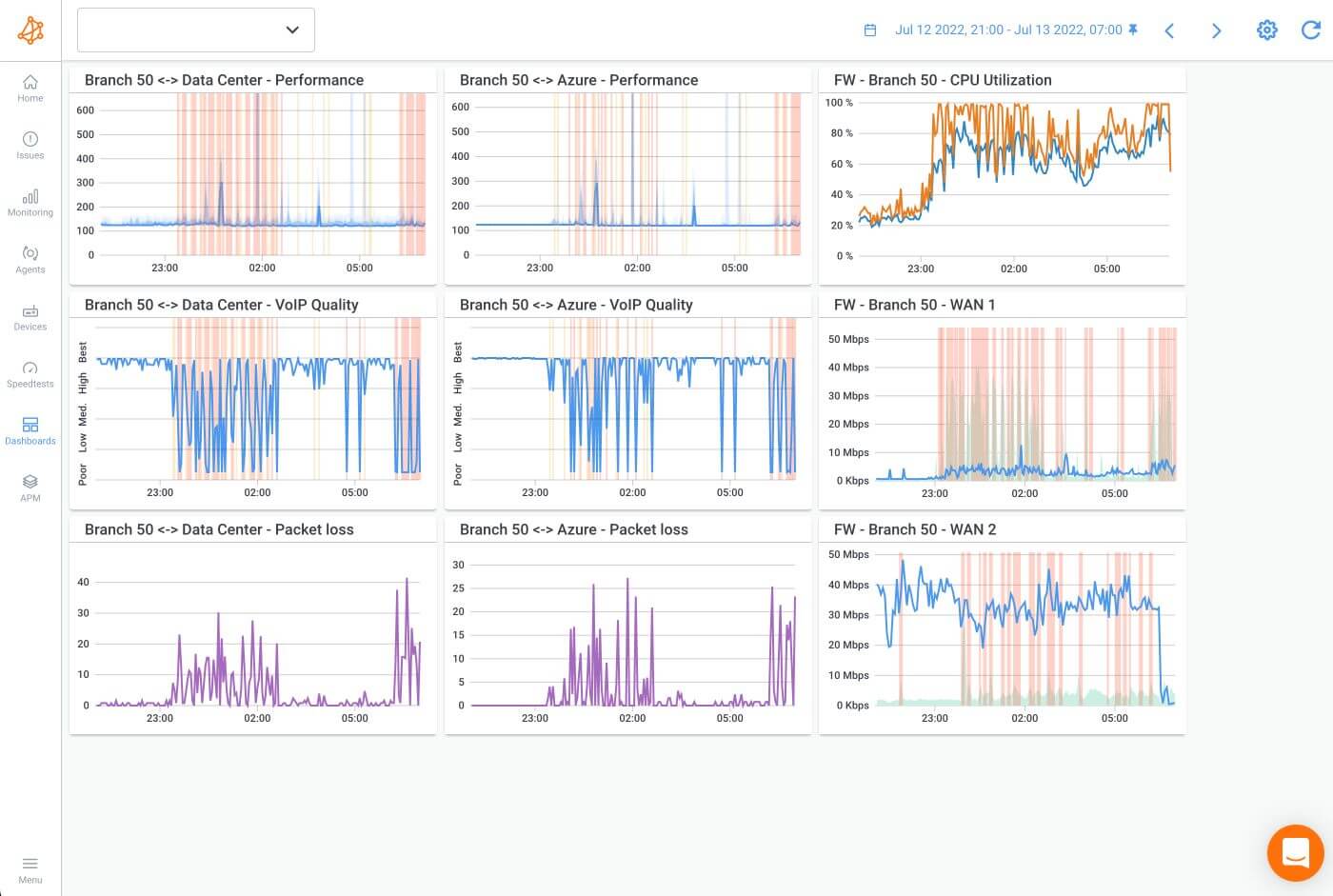
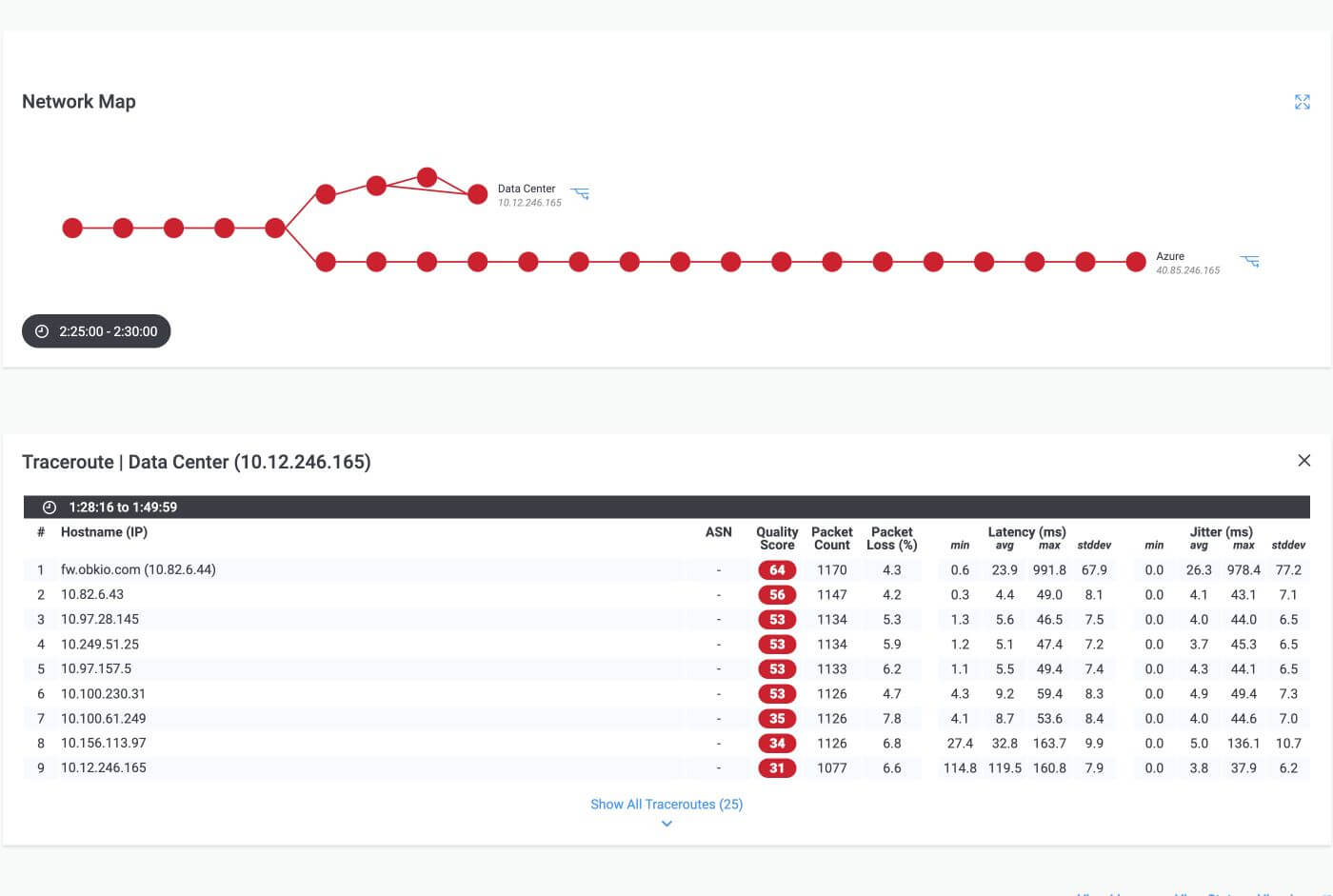
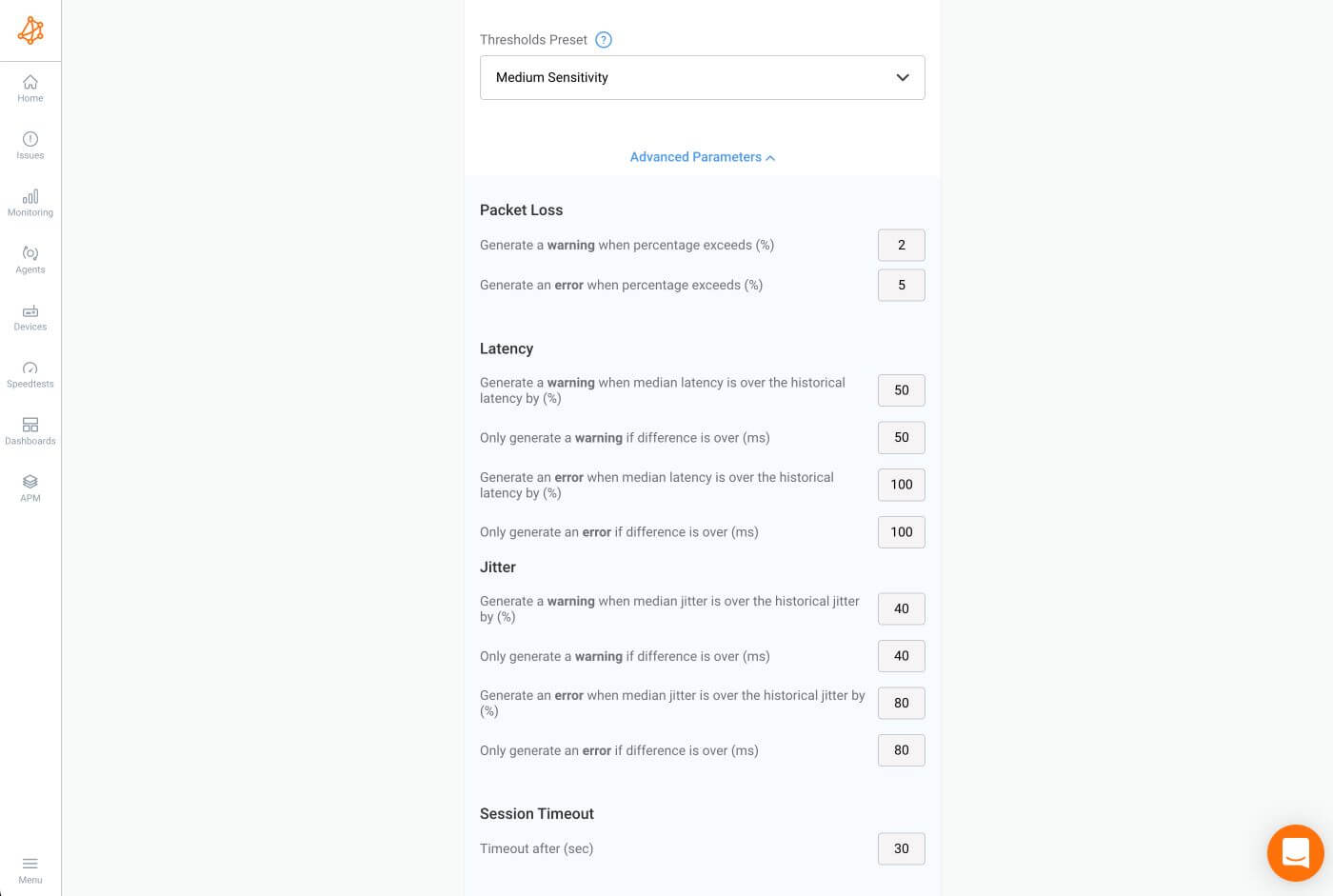
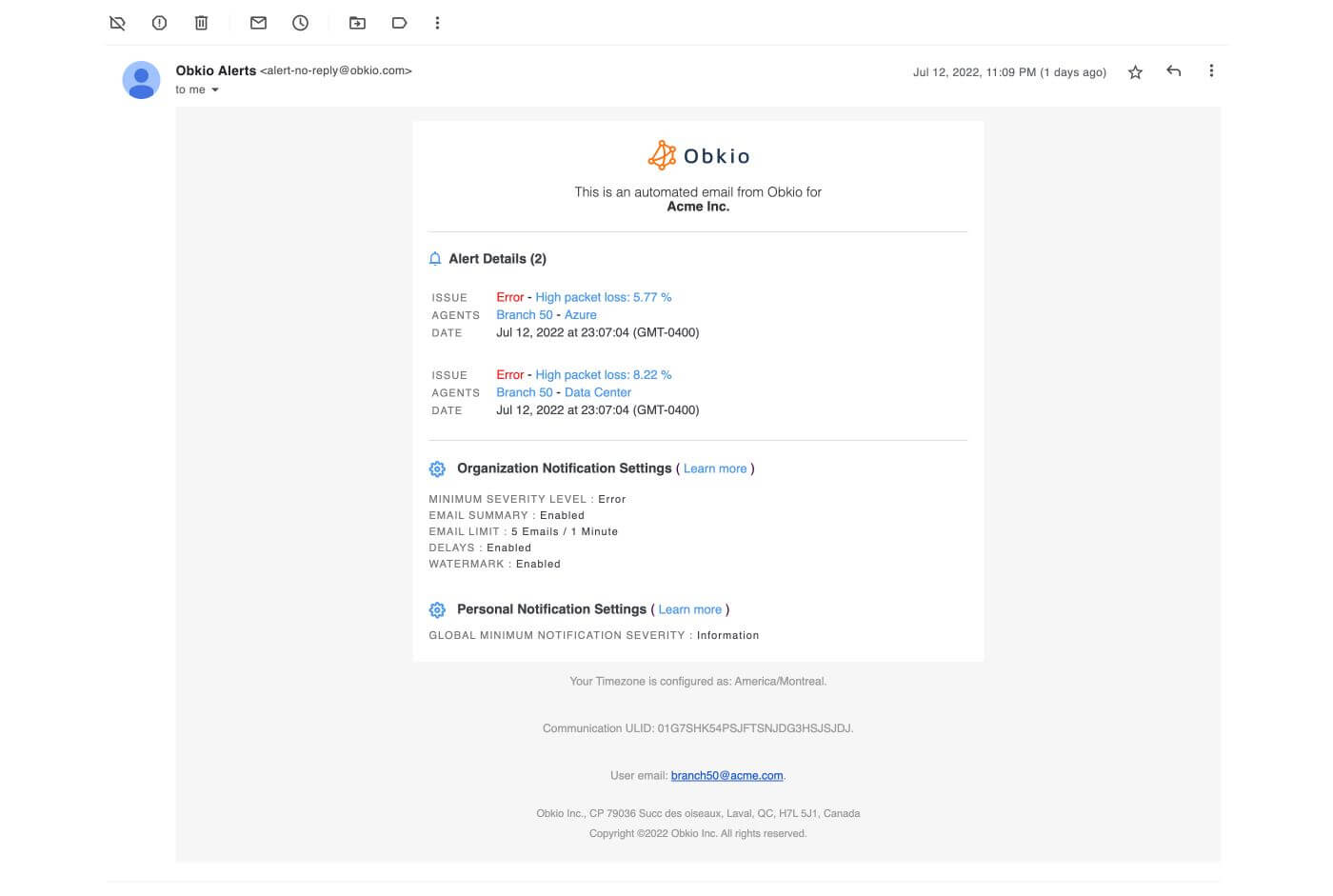
Be guided through how to identify and troubleshoot network problems with Obkio’s Network Monitoring app tour and features through screenshots.
Learn more

Obkio's Free 14-Day Trial
Obkio provides a complimentary 14-day trial of all of their premium features, enabling you to begin monitoring and troubleshooting network issues in matters of minutes. Within 10 minutes, customers can begin gathering performance data and detecting network problems with the aid of Obkio's Onboarding Wizard.
- 14-day free trial of all premium features
- Deploy in just 10 minutes
- Monitor performance in all key network locations
- Measure real-time network metrics
- Identify and troubleshoot live network problems

ThousandEyes is a network performance monitoring tool that offers real-time monitoring and analytics for network performance, application performance, and user experience. While it does offer synthetic monitoring capabilities, its primary focus lies in providing network intelligence and visibility through a combination of active and passive monitoring techniques.
ThousandEyes specializes in monitoring network performance from the perspective of end-users, applications, and networks across the Internet. It employs a blend of synthetic tests, such as DNS tests and HTTP server tests, along with real user monitoring (RUM) and network path visualization, to provide comprehensive insights into network performance and user experience.
ThousandEyes User Interface:

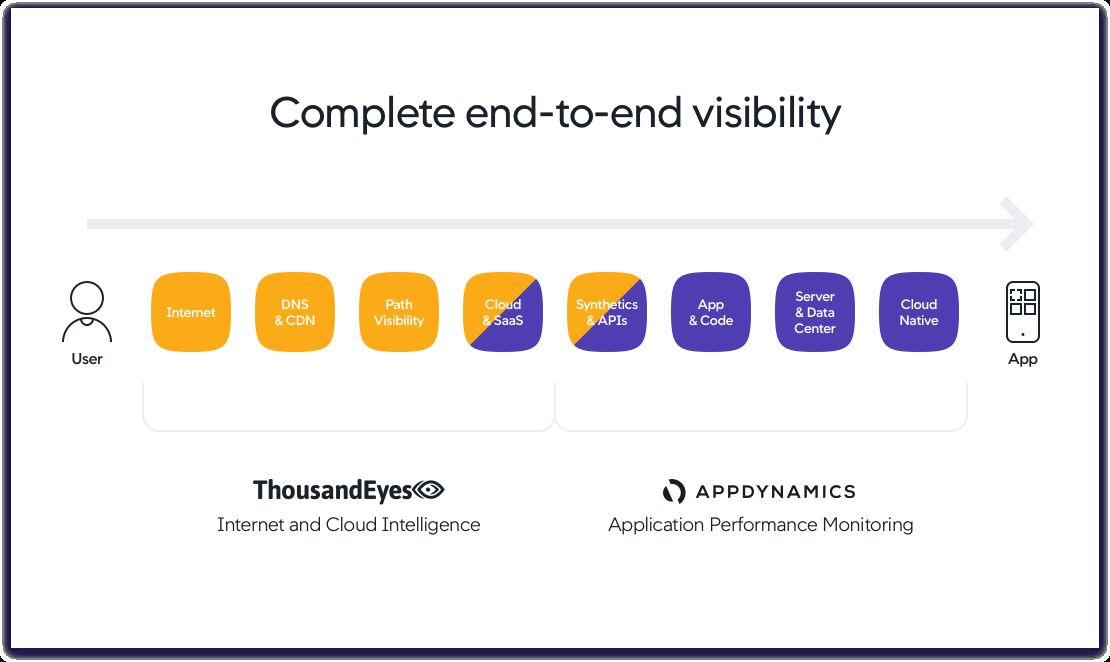
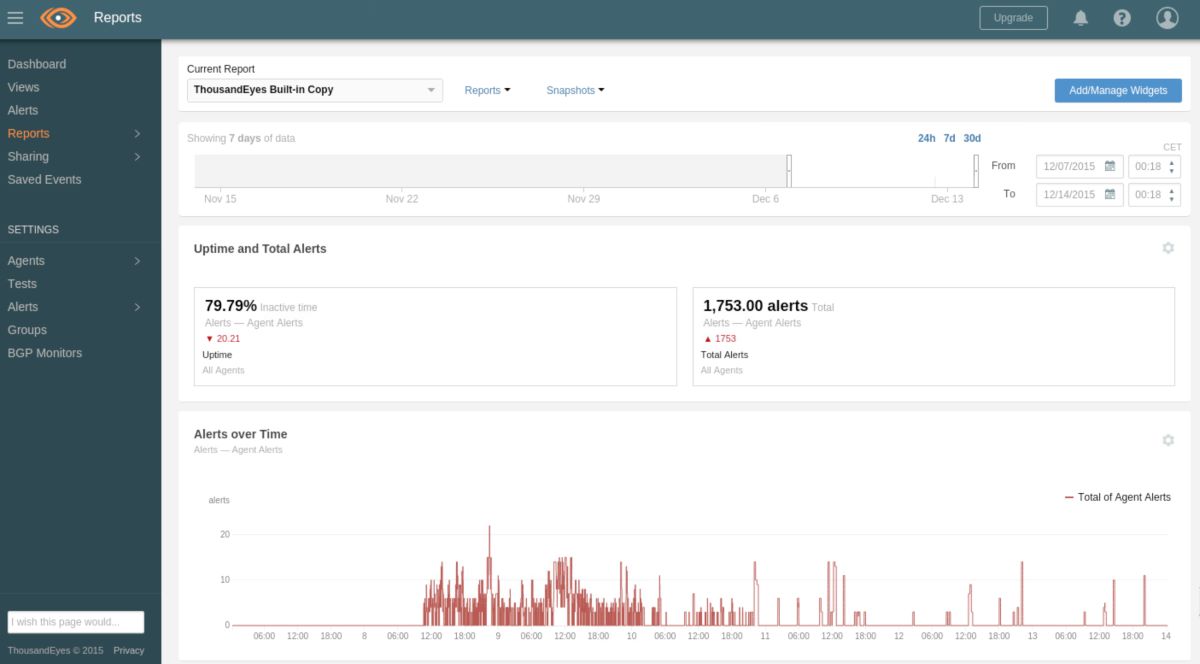

AppNeta is a network performance monitoring tool that offers real-time monitoring and analytics for network performance and application performance. AppNeta offers synthetic monitoring capabilities as part of its broader suite of monitoring solutions, but its focus extends beyond synthetic monitoring to encompass real-user monitoring and passive network monitoring.
While AppNeta does offer synthetic monitoring capabilities, it is not solely a synthetic network monitoring tool. Its platform encompasses a broader range of monitoring functionalities, including real-user monitoring and passive network monitoring, to provide comprehensive insights into application and network performance.
AppNeta User Interface:
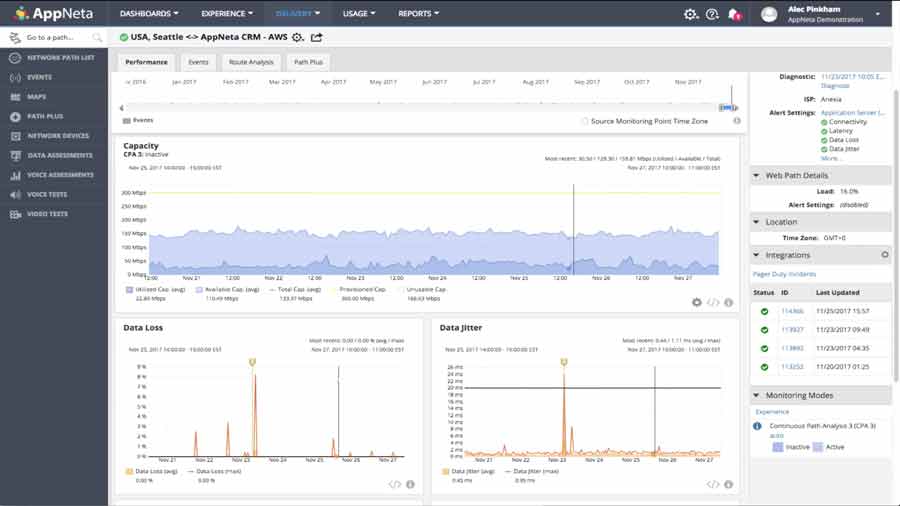
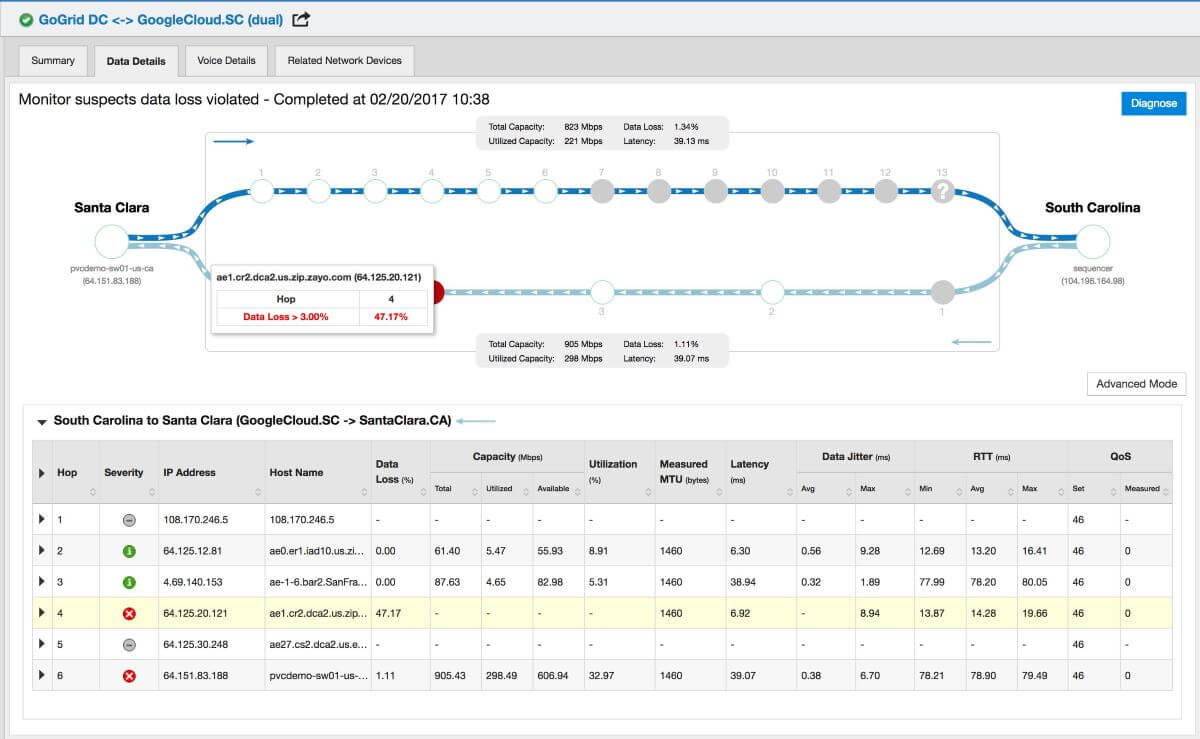
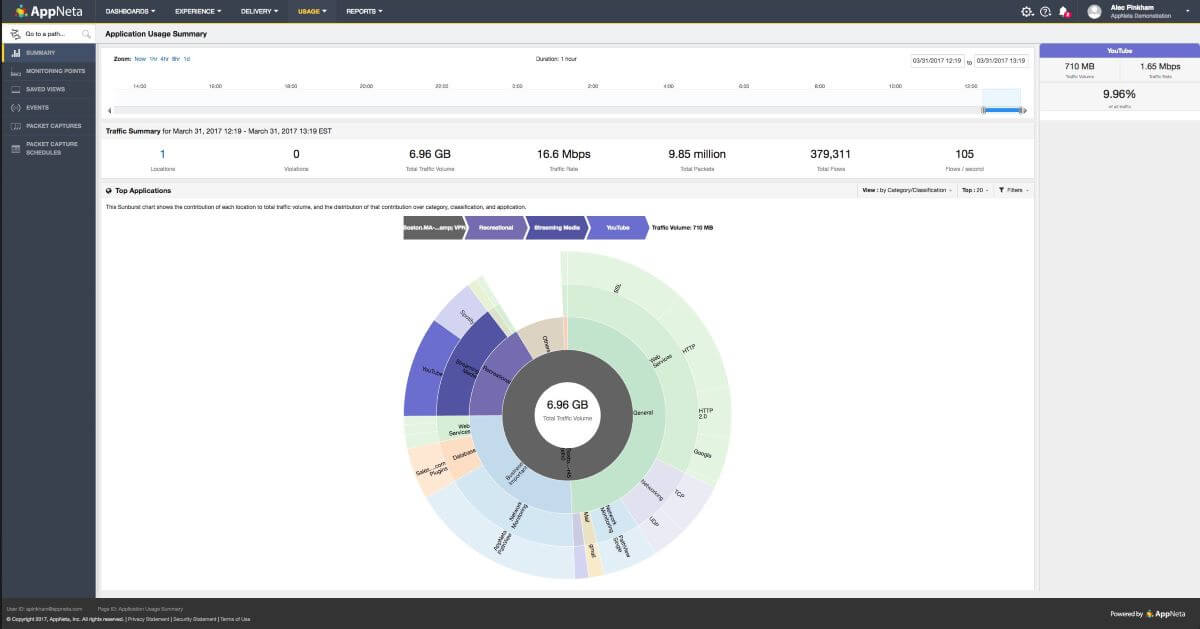
See how Obkio's Network Monitoring tool stands up against Appneta as the ultimate Appneta Alternative.

Traditional synthetic network monitoring tools offer a comprehensive suite of functionalities beyond network performance monitoring. In this section, we will delve into seven tools that encompass features such as availability monitoring, alerting, and incident response. These tools are designed to monitor and manage network infrastructure, ensuring the smooth operation of critical applications and services.
A comprehensive IT management software solution that offers network bandwidth monitoring capabilities. It provides real-time traffic analysis, bandwidth usage reports, device tracking, and more. It can monitor a variety of network devices and applications and offers customizable alerts and notifications to keep users informed of network performance issues.
While PRTG does offer some synthetic monitoring capabilities, such as HTTP, HTTP Advanced, and Ping sensors, these are just a small part of its overall feature set. Synthetic monitoring in PRTG allows users to simulate network traffic or interactions with specific network services to test their availability and performance from different locations. However, it does not offer the same level of emphasis on synthetic monitoring as dedicated synthetic monitoring tools like Obkio or other similar platforms.
PRTG User Interface:
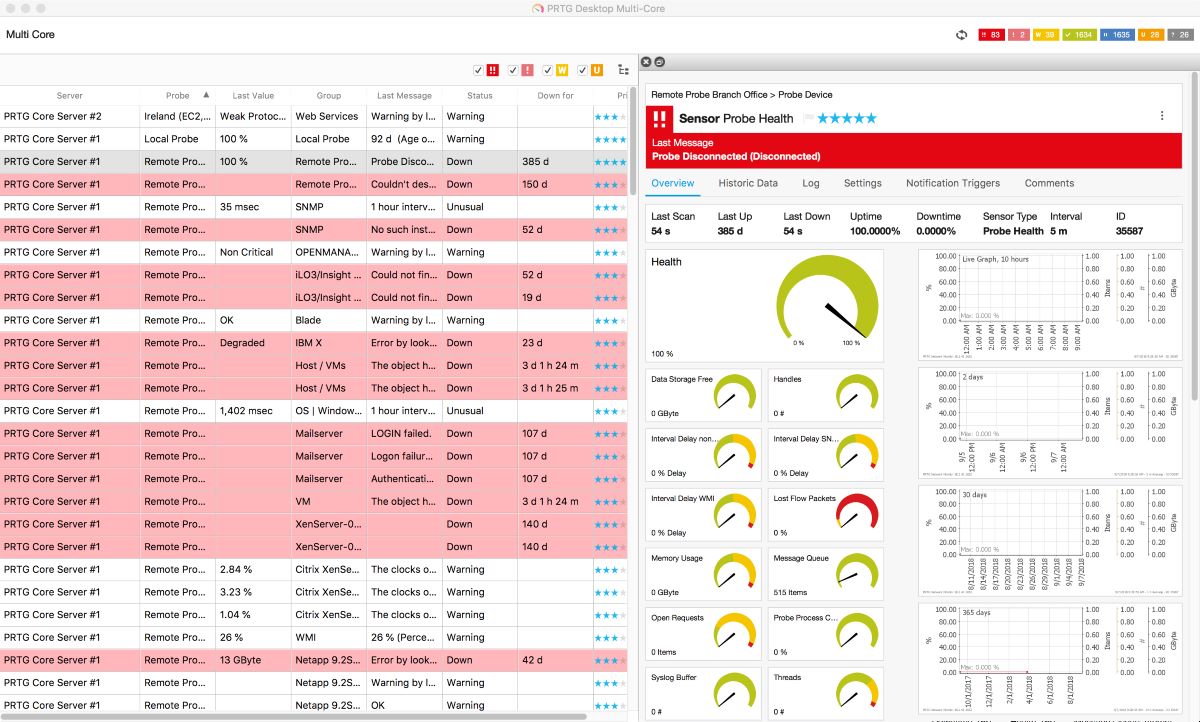

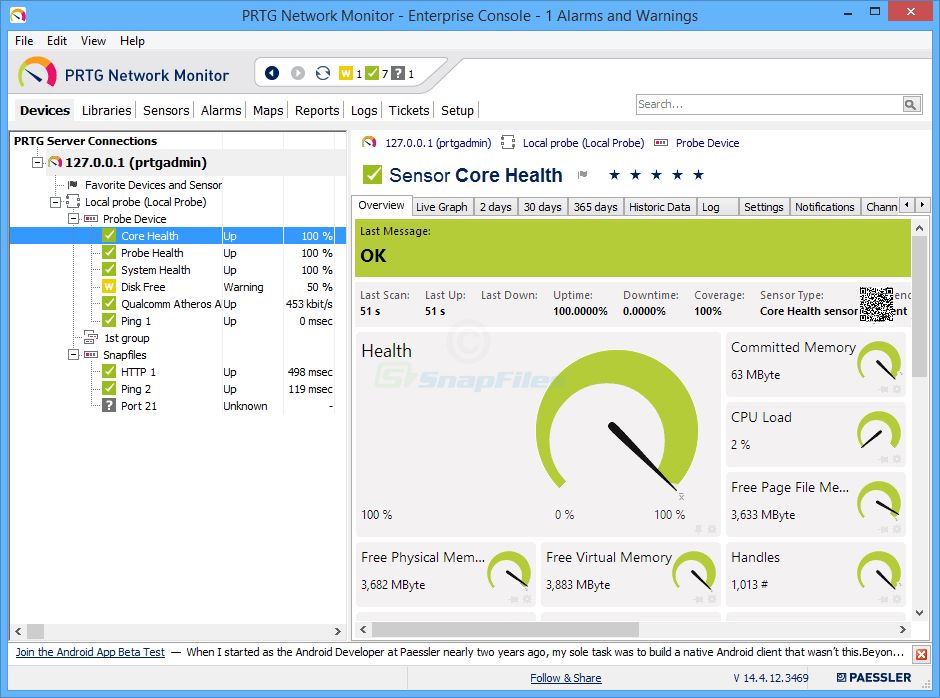

A popular IT management software solution that offers network bandwidth monitoring capabilities. It provides real-time traffic analysis, bandwidth usage reports, device tracking, and more. It can monitor a range of network devices and applications and offers customizable alerts and notifications to keep users informed of network performance issues.
While OpManager does not specialize in synthetic network monitoring like Obkio, it does offer some synthetic monitoring capabilities as part of its feature set. For example, OpManager includes synthetic transaction monitors that allow users to simulate transactions on web applications to assess performance and availability. However, synthetic monitoring is not the primary focus of OpManager.
Manage Engine OPManager User Interface:
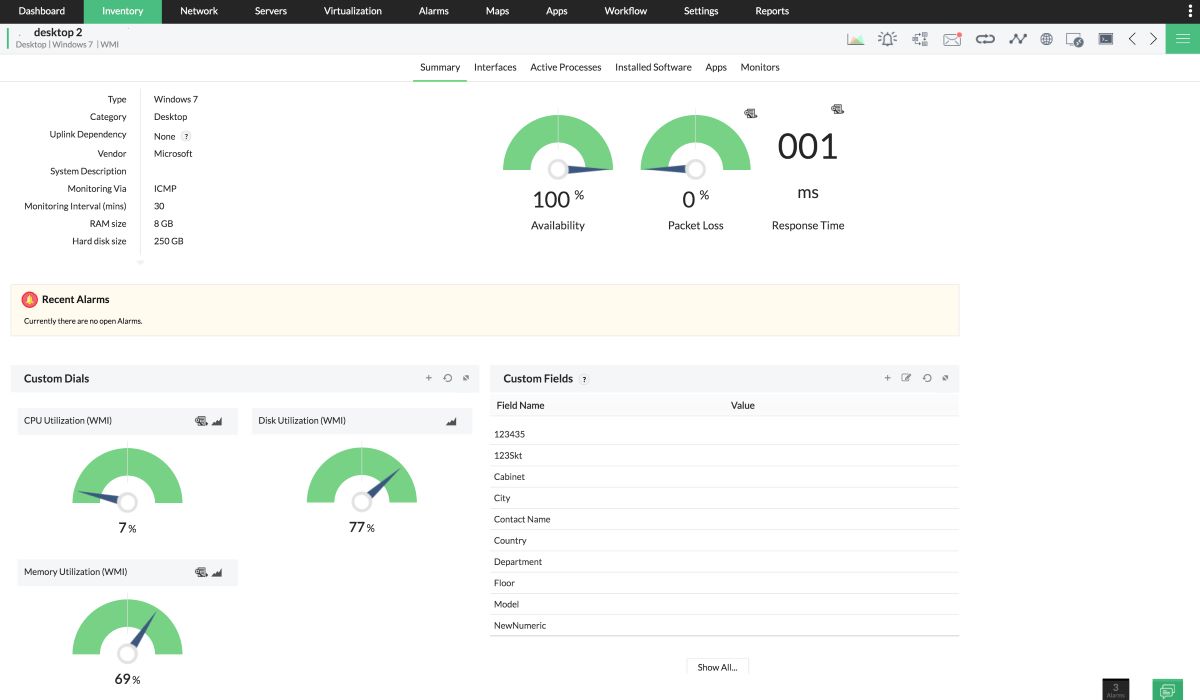

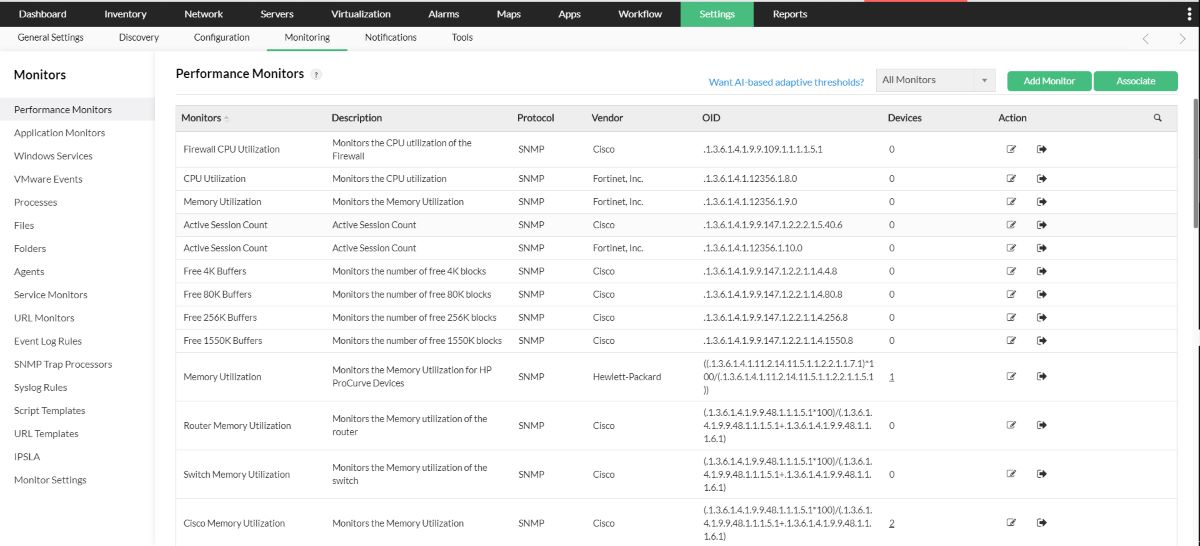

An IT infrastructure monitoring and management platform that offers network device monitoring, traffic analysis, and customizable alerts and notifications to help identify and troubleshoot network issues. It provides features such as SNMP monitoring, device discovery, performance monitoring, alerting, and reporting to help IT professionals effectively monitor and troubleshoot their network infrastructure.
While Progress WhatsUp Gold does include some synthetic monitoring capabilities, such as synthetic transactions for application monitoring, its primary focus is on real-time monitoring and management of network devices and resources. If your primary requirement is synthetic network monitoring, focusing on emulating user behavior and assessing end-user experience, you may want to consider dedicated synthetic monitoring tools like Obkio, which specialize in synthetic traffic generation and end-user experience monitoring.
Progress WhatsUpGold User Interface
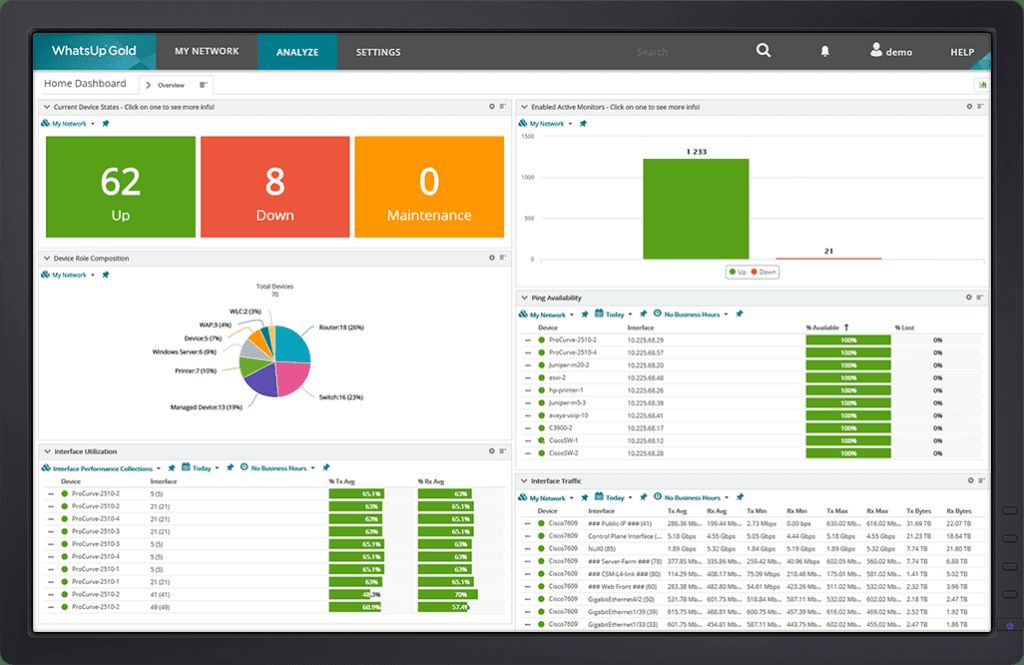
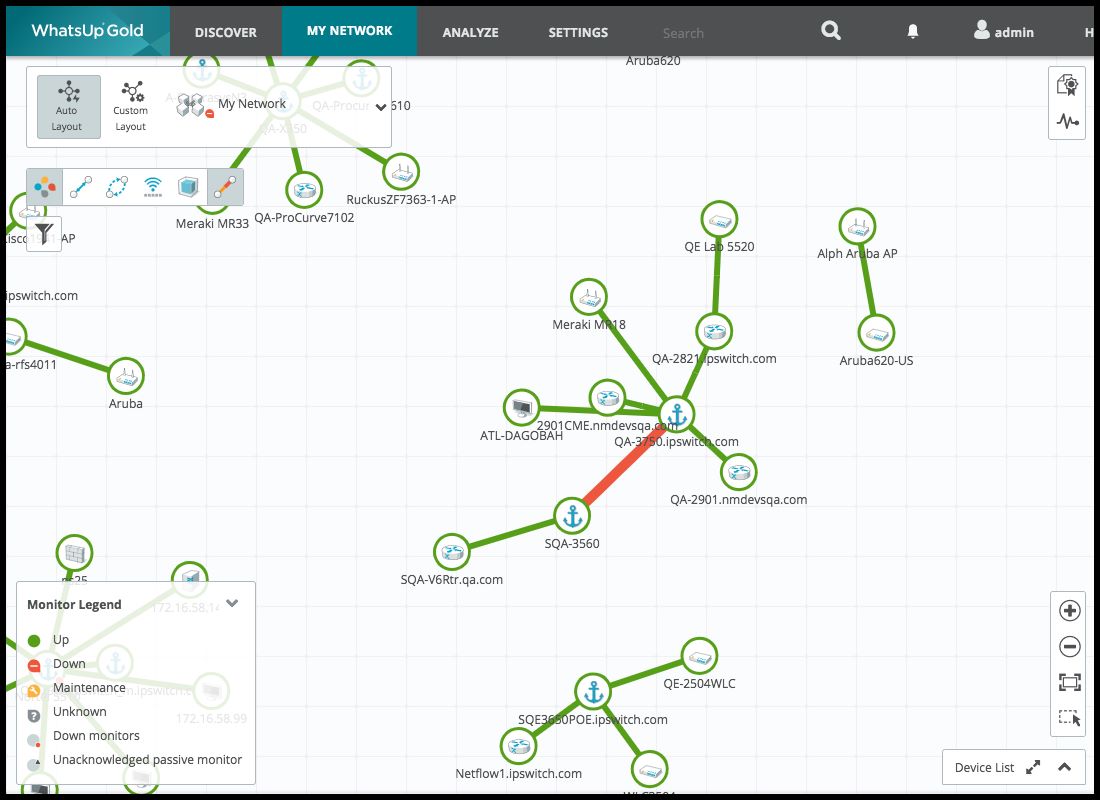
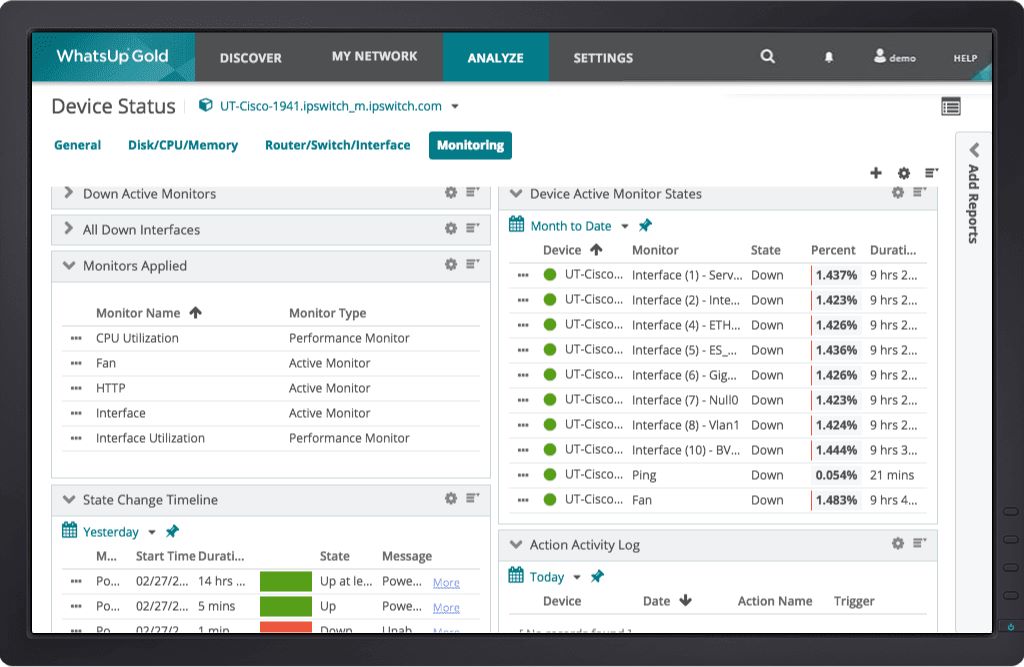

Ixia/Keysight Network Monitoring is a network monitoring and testing solution that offers real-time network monitoring, network traffic analysis, and security testing capabilities.
While the terminology used may vary, Ixia's solutions include features for generating synthetic traffic to simulate user behavior and monitor network performance proactively. These capabilities enable organizations to assess network performance from an end-user perspective, identify potential issues, and optimize network infrastructure to ensure optimal performance.
Ixia/Keysight User Interface:
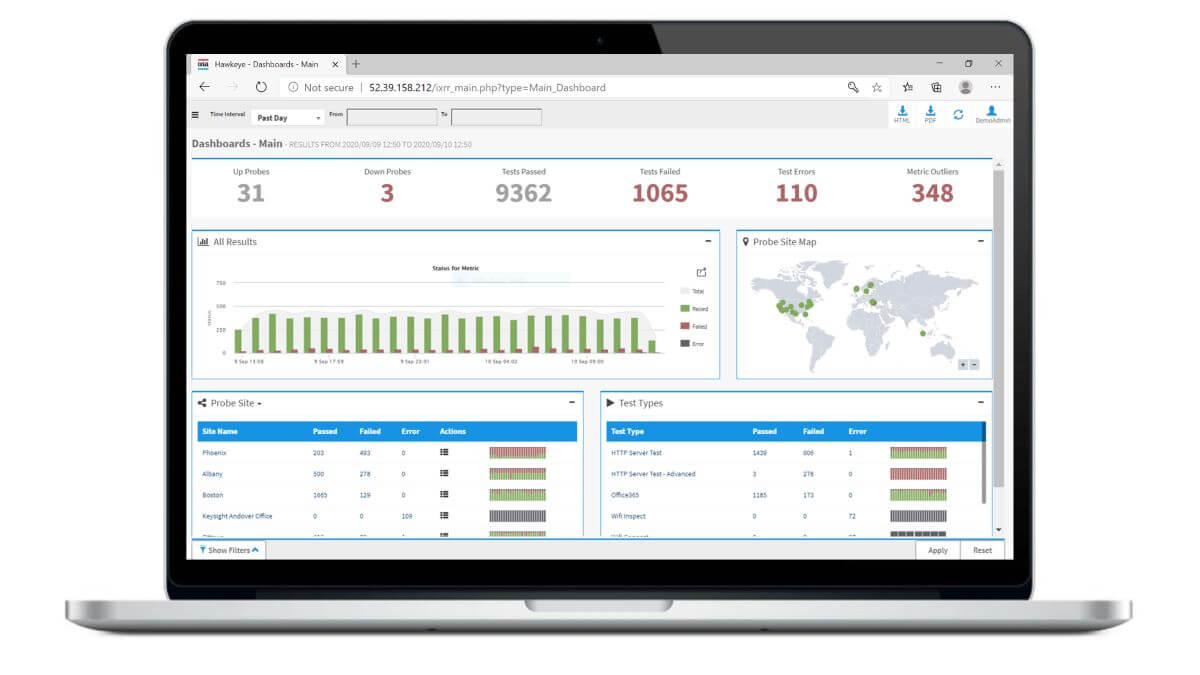
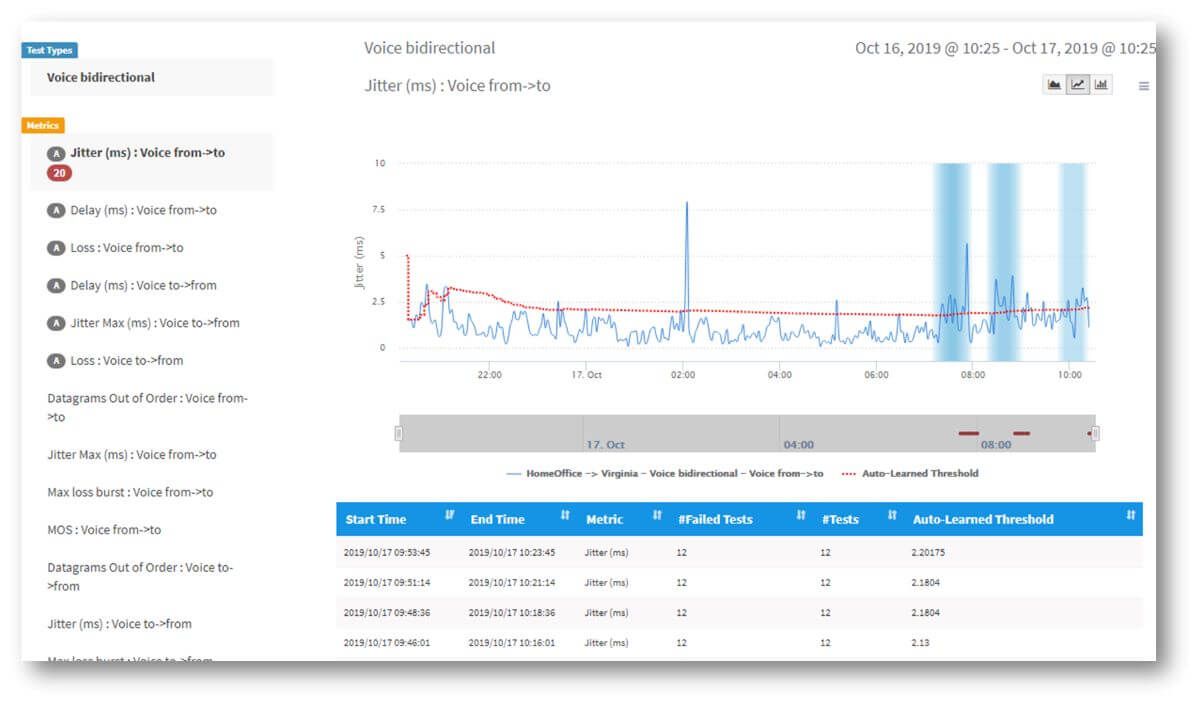
Combining the power of synthetic monitoring with application performance monitoring (APM) capabilities, these tools offer a holistic view of the user experience. In this section, we will examine 3 tools that not only simulate network transactions but also provide insights into application-level performance. These solutions facilitate quick identification and resolution of performance issues across both the network and application layers.
LogicMonitor is a comprehensive network and application performance monitoring platform that offers synthetic monitoring solutions to ensure optimal performance across networks and applications. With a focus on synthetic transaction monitoring, LogicMonitor enables organizations to simulate user interactions and accurately measure application responsiveness.
Using LogicMonitor's synthetic transaction monitoring, organizations can replicate user actions such as logging in, browsing web pages, and completing transactions within applications. By continuously simulating these interactions, LogicMonitor provides valuable insights into application responsiveness, latency, and overall user experience.
LogicMonitor User Interface:
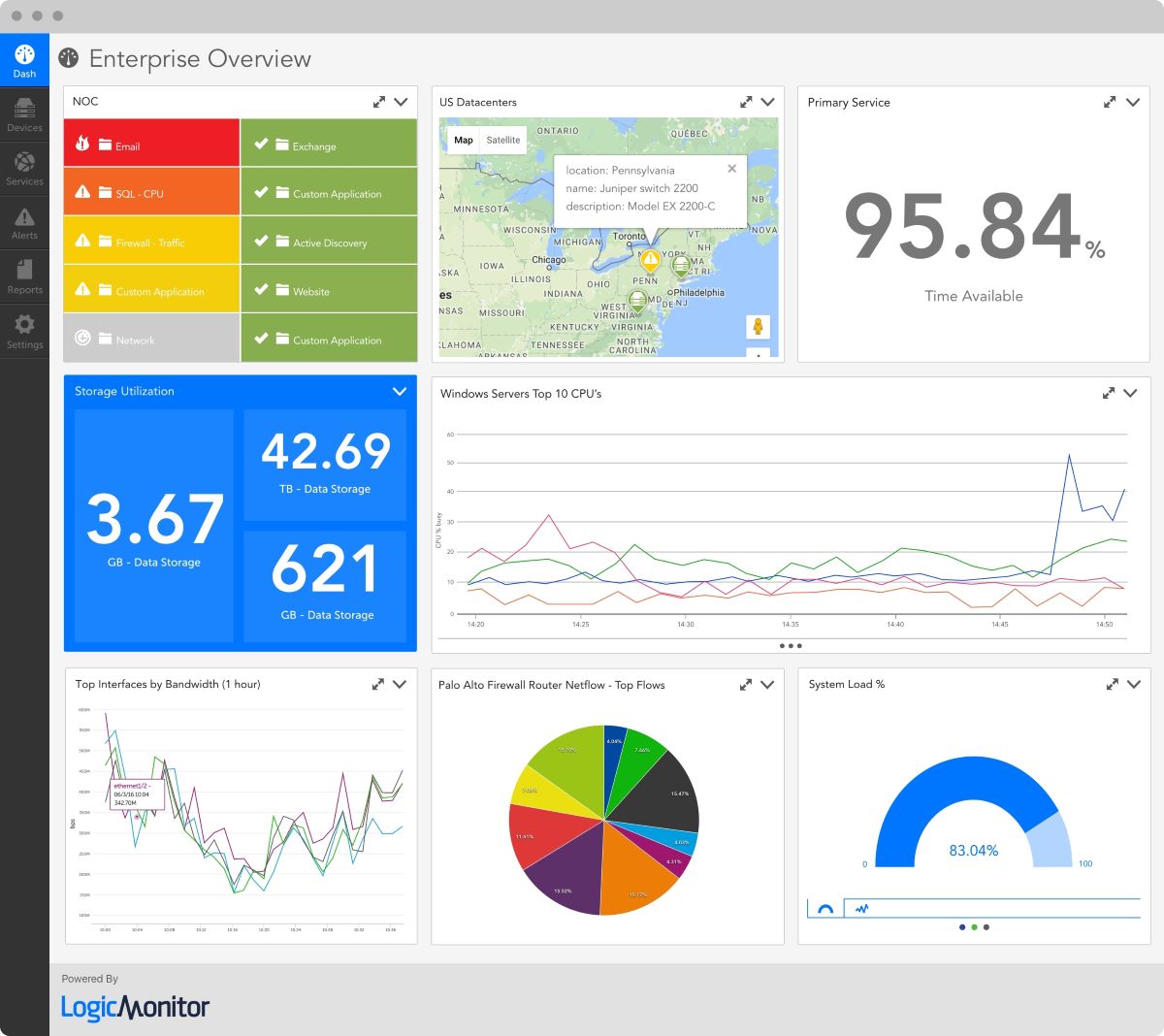
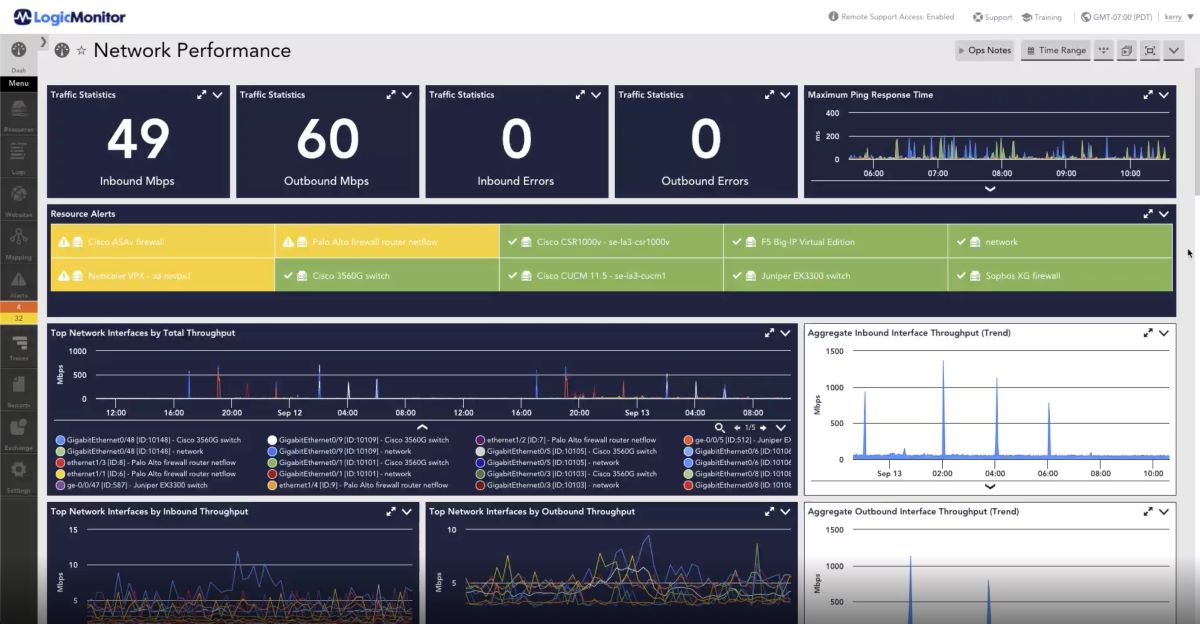
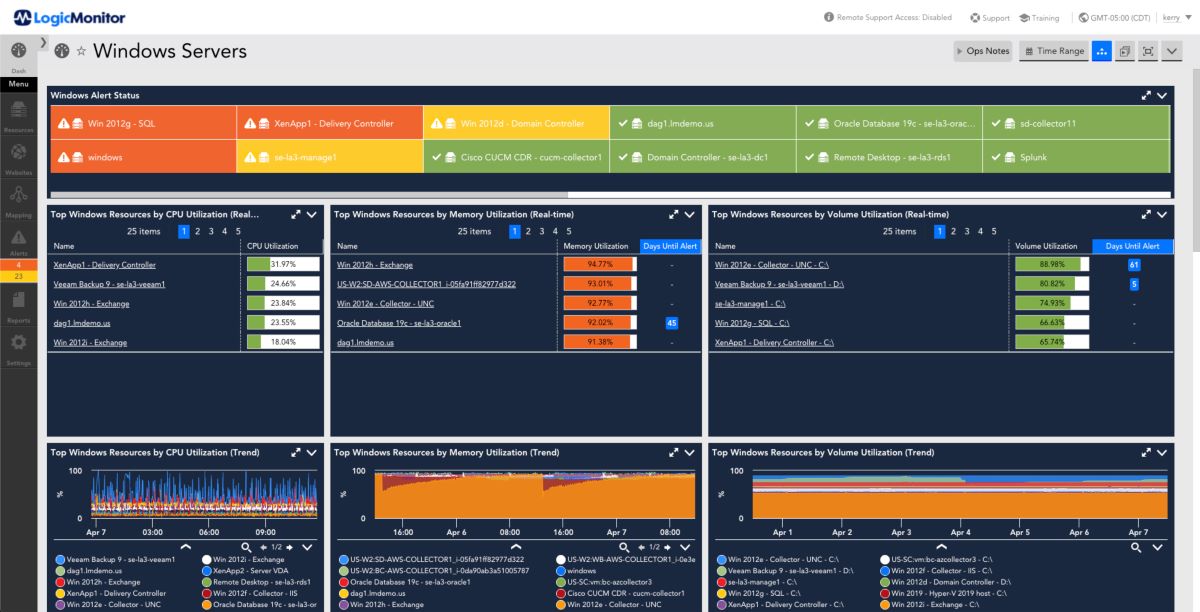

Dynatrace is a leading application performance monitoring (APM) solution that provides comprehensive insights into the performance and availability of applications and digital services. While Dynatrace is primarily known for its application-centric monitoring capabilities, it also offers synthetic monitoring features that extend to network performance assessment.
While Dynatrace's primary focus is on application performance monitoring, it also provides limited network monitoring capabilities. This includes the ability to monitor network latency and throughput between application components and endpoints.
Dynatrace User Interface
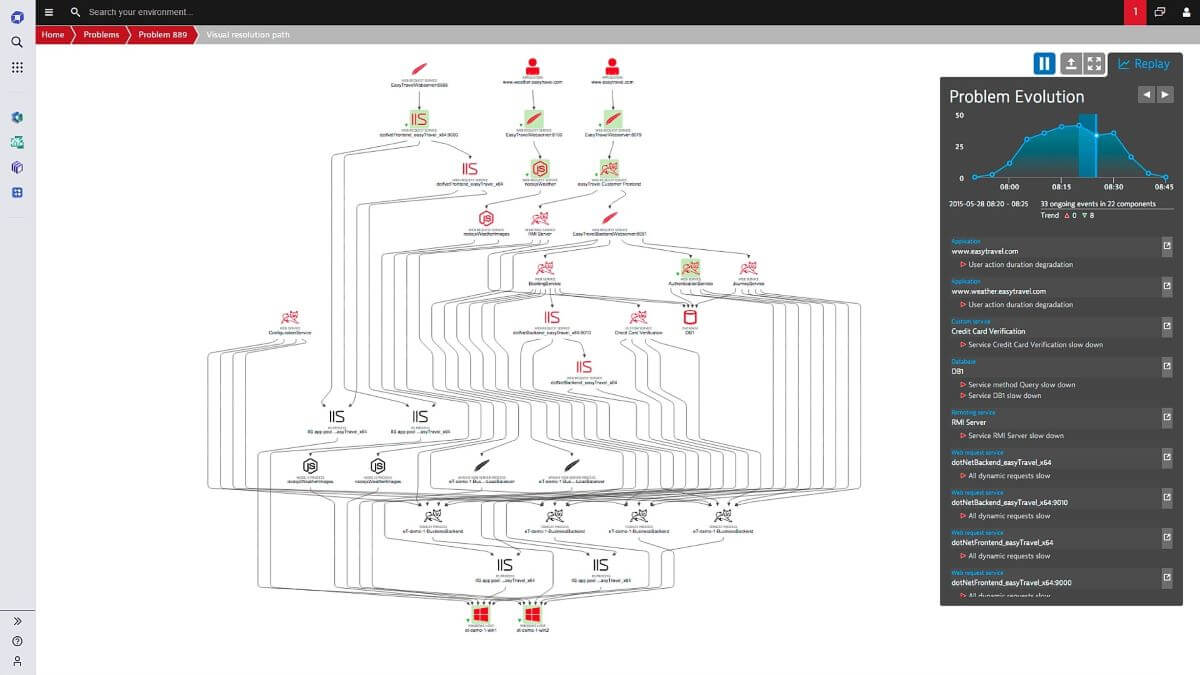
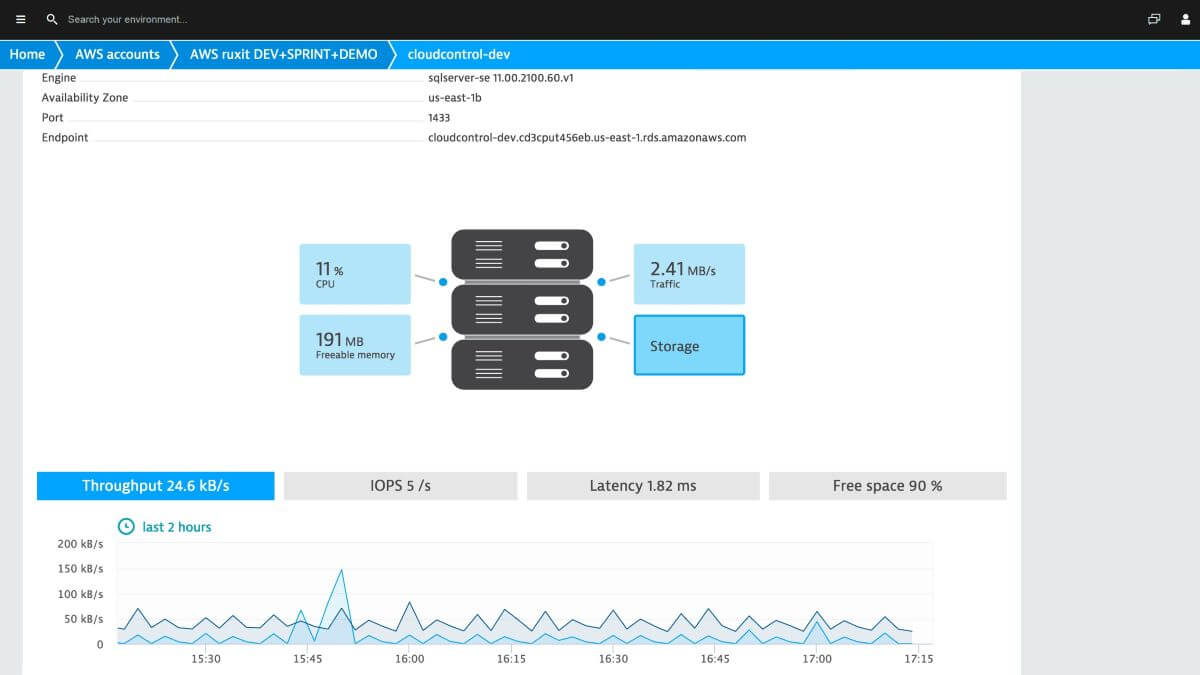
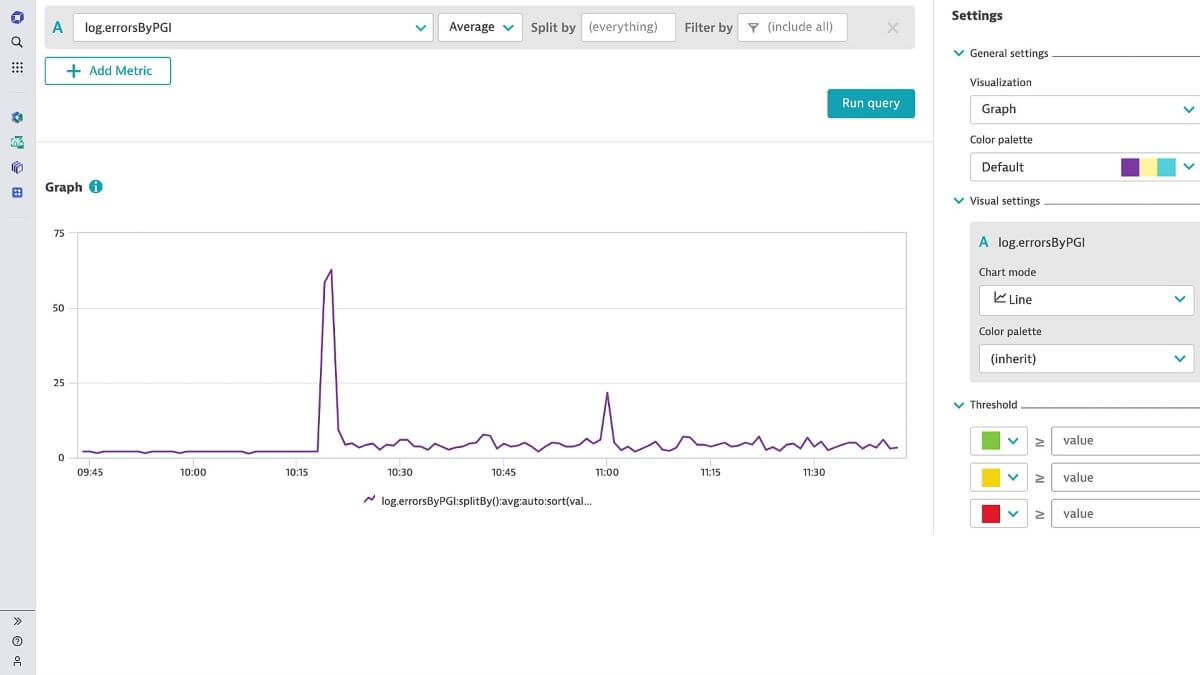
Netreo is a comprehensive network monitoring platform that specializes in providing insights into both application and network performance. Netreo allows users to create synthetic transactions that simulate real user interactions with web applications.
Netreo offers network performance monitoring capabilities to assess the latency, packet loss, and throughput of network connections. In addition to network monitoring, Netreo provides APM capabilities to monitor the performance of applications and services.
Netreo User Interface



Datadog is a monitoring and analytics platform that offers end-to-end visibility into network performance, infrastructure, and applications. offers comprehensive network monitoring capabilities. Datadog offers synthetic monitoring capabilities, including network monitoring, as part of its broader observability platform.
Datadog Synthetic Monitoring allows organizations to simulate user interactions with web applications and monitor network performance from various geographic locations. It provides insights into application responsiveness and user experience, allowing organizations to identify and address performance issues before they impact end-users.
Datadog User Interface:

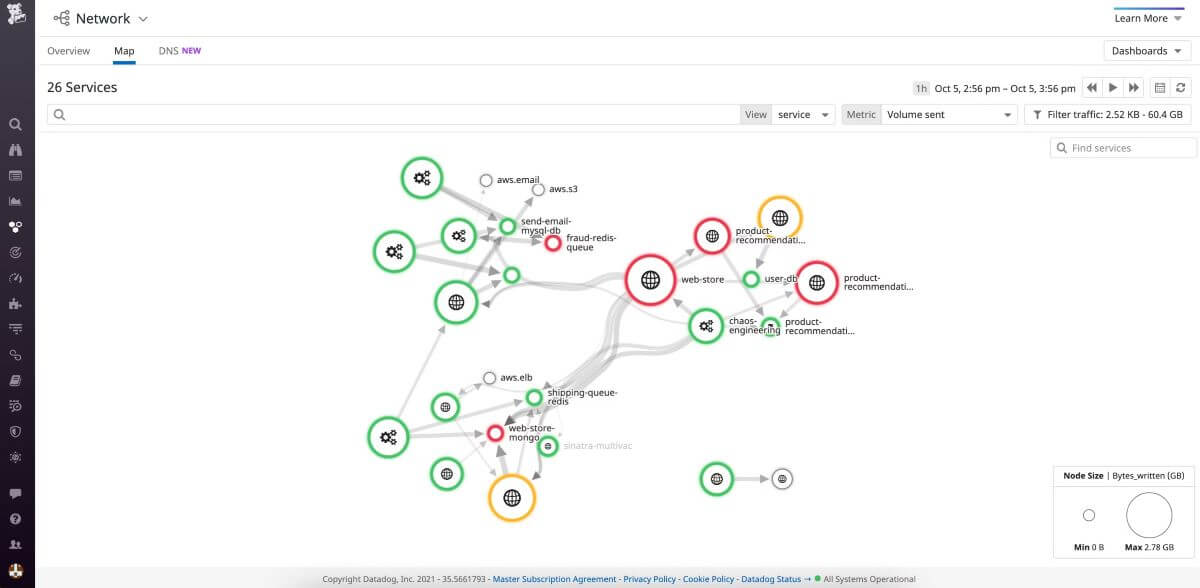
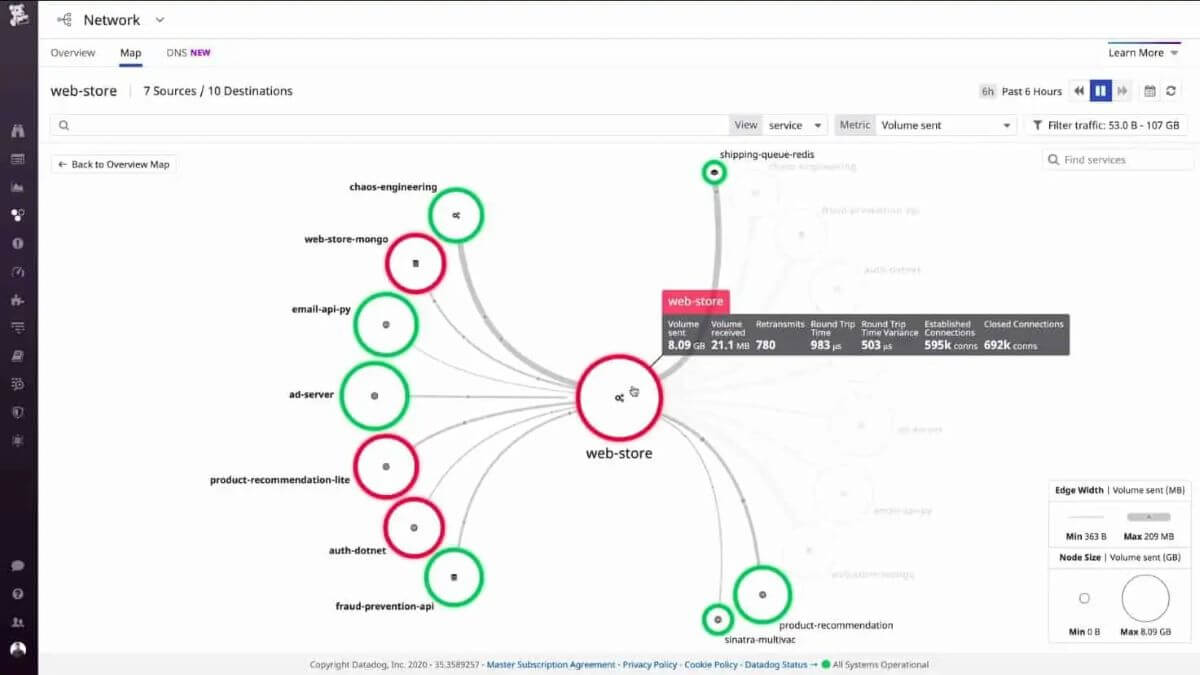
This section explores web performance monitoring solutions equipped with synthetic network monitoring capabilities, enabling businesses to proactively evaluate, analyze, and improve the functionality of their web applications in a variety of network environments. By leveraging synthetic network monitoring features, these solutions provide invaluable insights into end-user experience, network latency, and application responsiveness, enabling organizations to identify and address performance issues before they impact user satisfaction and business outcomes.
Pingdom is a widely recognized tool primarily used for website monitoring, offering a suite of features to ensure website availability, performance, and user experience. However, beyond its foundational website monitoring capabilities, Pingdom also provides synthetic monitoring functionality. This synthetic monitoring aspect allows users to simulate user interactions with web applications and assess network performance from various locations worldwide.
Pingdom User Interface:


Dotcom-Monitor is a comprehensive synthetic monitoring solution that specializes in monitoring both website and network performance. With its suite of monitoring tools, Dotcom-Monitor enables organizations to proactively assess the availability, reliability, and speed of their digital assets from various locations around the world.
Dotcom-Monitor allows users to create synthetic transactions that simulate real user interactions with websites and web applications to continuously monitor the availability of websites and web applications from multiple checkpoints around the world. It also provides network performance monitoring capabilities to assess the latency, packet loss, and throughput of network connections.
Dotcom-Monitor User Interface:



Navigating the World of Synthetic Network Monitoring Tools with Confidence, and a Simple Solution to Get Started
We hope that this comprehensive article has provided you with valuable insights into the world of synthetic network monitoring. By categorizing and exploring different families of tools, we aimed to simplify the process of comparing and selecting the most suitable solution for your network monitoring needs.
Whether you are seeking pure synthetic network performance monitoring, traditional synthetic network monitoring, or application performance monitoring with synthetic monitoring capabilities, we've covered a range of tools that cater to diverse requirements.
While the selection process can be overwhelming, we want to emphasize that there are solutions available to suit every organization's needs. If you're looking for a simple and easy-to-use solution that can get you started within minutes, we highly recommend Obkio.

Obkio's Network Monitoring tool offers a user-friendly approach to synthetic network monitoring, empowering you to optimize network performance, identify and resolve issues quickly, and ensure exceptional user experiences. With its intuitive interface and streamlined setup process, Obkio allows you to start monitoring your network with ease and efficiency.
So, whether you're a small business, an enterprise, or an IT professional seeking a hassle-free solution, consider exploring Obkio to kickstart your journey into synthetic network monitoring.
Experience unparalleled network performance optimization with Obkio, the ultimate synthetic network monitoring tool. Elevate your monitoring game and ensure optimal network performance with our comprehensive suite of synthetic monitoring capabilities. From simulating user behavior to continuously measuring network metrics, Obkio empowers organizations to proactively identify and address performance issues before they impact end-users.

We hope this article has provided you with the knowledge and insights necessary to make informed decisions and embark on a successful network monitoring journey. May your networks remain robust, reliable, and ready to meet the demands of the ever-evolving digital landscape.
This page is compiled from the information available on the software’s official website. We have made every attempt to ensure the accuracy and reliability of the information provided in this article. However, the information is provided “as is” without warranty of any kind. Obkio is not liable for any inaccuracies in the article due to changes made on their websites or any development made to their products after the date of publication of this article. Please refer to their websites for more information.


























 Obkio Blog
Obkio Blog





